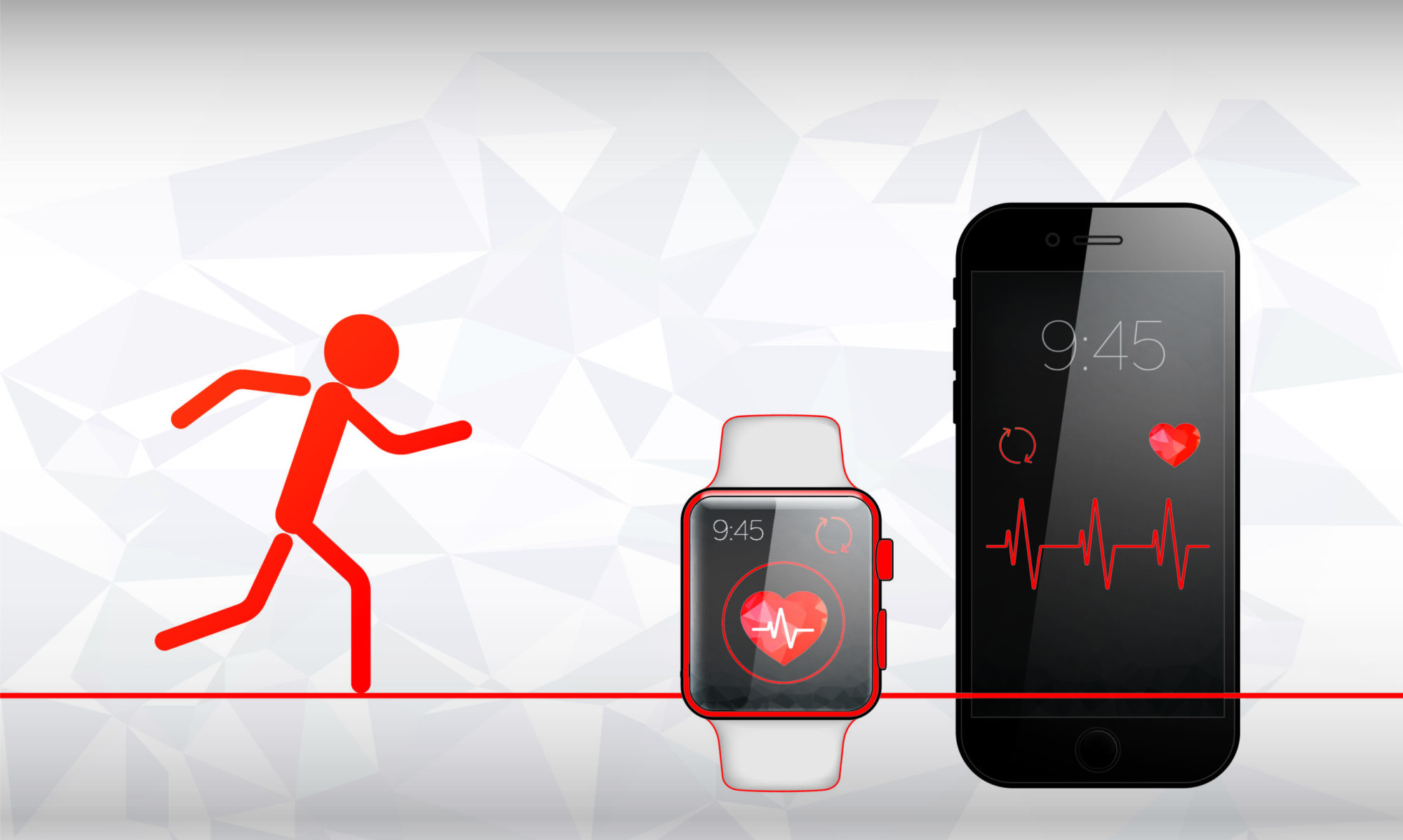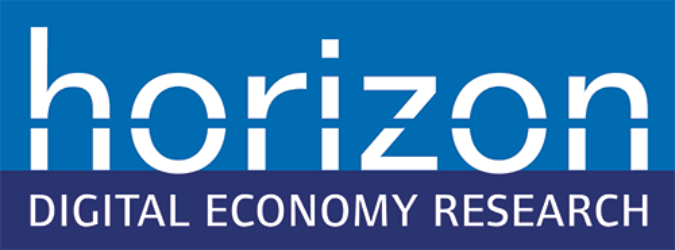The first 6 months of W-WATI have been busy and very productive!
The first stage of our study exploring workplace wellbeing and the internet was to define workplace wellbeing. To this end, we conducted a literature review (Workpackage 1), which showed that wellbeing can be defined in myriad ways that are impacted by factors such as time-period, gender, age, culture, and individuality.
As a team, we discussed the literature and settled on the following definitions of wellbeing:
- An overall/general subjective feeling of satisfaction, optimism, or happiness about life
- Functioning well and with a sense of purpose
- Feeling content about activities engaged in
Once we had our definitions, we returned to the literature to understand specific factors that went into workplace wellbeing. Across the literature we saw metrics that aimed to capture job satisfaction, job demands, workplace values, home life, personal and professional goals, personal and professional opportunities, individual autonomy, and social support. Common ways of capturing these metrics included, but are not limited to, sense of purpose, optimism, anxiety, loneliness, happiness, satisfaction, and time for activities.
This understanding of workplace wellbeing subsequently allowed us to seek more information about ways that being online might impact workers. These impacts were broadly negative, and common impacts were noted to be: feeling unable to ‘switch off’; suffering from information overload; feeling pressured to multitask beyond what is comfortable; and increased negative emotions such as anxiety, stress, and alienation.
How do people feel about workplace wellbeing and the Internet?
In the next stage of the project, Workpackage 2, we ran on online questionnaire to elicit perspectives on how using the Internet and Internet-based technologies can affect wellbeing in the workplace. Our questionnaire aimed to capture details of respondents’ workplace experiences, time spent online at work and feelings about being online at work. We particularly focused on the topic areas that will be addressed later in the project in Workpackages 3,4 and 5. We circulated the questionnaire across our networks and the Prolific platform – a business that puts researchers in touch with participants. We received 248 responses. Respondents’ ages ranged from 18 to 71, with an average of 38 years old. Just over half of the participants (56.9%) were female.
Alongside questions about how people spend their work time online, we had several measures of aspects of wellbeing: ratings of current wellbeing in relation to work, how stressful their job is, technostress (the psychological impact of technology use at work), and general wellbeing. On average, participants rated their workplace wellbeing fairly high (3.54/5) with 52.4% feeling it was ‘somewhat good’; job stress was lower (2.71/5) with 41.5% stating ‘a little stressful’ and 28.2% ‘fairly stressful’, technostress was low medium (3.10/6), and overall wellbeing was moderate (3.9/6).

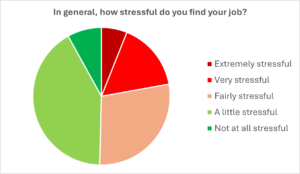
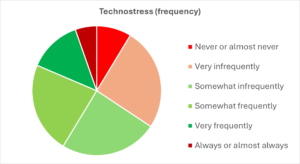
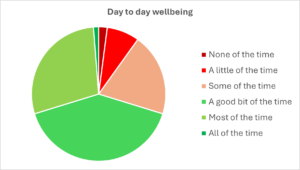
Online/offline balance
The focus of Workpackage 3 is on online/offline balance. This means the optimal balance of time spent online and offline for a person’s wellbeing in relation to work. Initial analysis of the questionnaire results revealed no significant differences in reported wellbeing in relation to work; across different work sectors or role types (i.e., whether respondents worked in full time, part time, self-employed, volunteer or multiple roles), gender and age of respondents, level of control over internet use at work, or confidence in using internet technology . Finally, there is no relationship between wellbeing and time spent on the internet, whether this is for work or for leisure, or background (time spent online indirectly) or active internet use.
We hoped that the questionnaire results would help us to narrow down the focus of our investigations. This is not the case, but they do chime with the ‘assumptions’ we made at the beginning of our project. From the outset, we have been careful not to assume that an online/offline imbalance will negatively or positively impact someone’s wellbeing. For example, one person may find that a small amount of time spent online is detrimental to their wellbeing, whilst someone else may find that being hyperconnected (the focus of Workpackage 4) supports their wellbeing. The questionnaire results indicate that wellbeing is very individual experience and not related to wider identities including age, gender or job sector.
Next, we will hold focus groups with workers of different ages, genders, and role types, working across a range of industries. We aim to uncover barriers and facilitators to achieving optimal online/offline balance that can be shared with others across job sectors to support wellbeing in the workplace. We originally planned to group participants by industry or role type but the questionnaire results suggest that mixed groups will be appropriate and that ‘optimal’ online/offline balance for wellbeing is down to individual preference and experience. This means that the guidance we go on to produce will likely be tailored more towards individual needs, for example, to support anyone who recognises that an imbalance in their online/offline activities is negatively affecting their wellbeing in the workplace.
Hyperconnectivity
Hyperconnectivity, the pressure to always be available and the blurring of work-life boundaries caused by constant digital connectivity, is the focus of Workpackage 4. The questionnaire results show that 10.9% of participants considered themselves to be hyperconnected ‘a great deal’ or ‘an extreme amount’, whilst 21.8% did not consider themselves to be hyperconnected at all. Looking at correlations between factors, it appears that the more hyperconnected someone considers themselves to be, the lower they rate their work wellbeing and overall wellbeing, and the higher they rate the stress levels of their job and their technostress. Our next steps are to carry out a series of interviews with people who consider themselves hyperconnected, and those who do not, to understand their different perceptions of how the internet affects their workplace wellbeing. Some people who find themselves hyperconnected may see this as a positive thing, whilst some may experience it negatively, so these interviews will help us to get at these nuances.
Dealing with negative online content in the workplace
Just over 34% of our participants stated that they deal with online content posted by others as part of their work. Of those, 16.5% of participants stated that their job involves dealing with excessively negative online content every day and 14% stated that their job requires them to deal with this kind of content a few times a week. Only 5% answered that they never have to deal with excessively negative online content in their job. In Workpackage 6 we are particularly interested in what workplaces do to support their staff when they are faced with excessively negative or even hostile online content as part of their work. Of the participants who told us that their work involves dealing with online content posted by others, 35% stated that their workplaces do provide some form of support for dealing with excessively negative or hostile online content. Of these respondents, 80% said they were either completely or mostly satisfied that the support their workplace provides is sufficient; the remainder said they were either somewhat or a little bit satisfied that it is sufficient. We intend to find out more about workplaces that do (and do not) currently provide support for staff when dealing with excessively negative or hostile online content and what best practices workplaces can adopt to prevent their staff from being harmed by coming into contact with this content.
Questionnaire reflections
The questionnaire produced some interesting and perhaps unexpected findings about how wellbeing, the Internet and the workplace interact. For example, it was pleasing to see that the survey reached people from a broad range of occupations, who use the internet in varied and different ways – which promises to provide fascinating insights into areas of work that we are not familiar with. Also interestingly, a first impression is that overall, judgements of the effect of the internet on wellbeing appeared to be more positive than perhaps we had expected. Many respondents reported seeing the benefits to wellbeing that the Internet brings. Having said this, a range of responses were captured. Given the variety of workplaces and roles represented and the range of positive and negative views, our next task is to explore the data in more detail, to identify potential patterns to see if and where these first impressions are supported and build on the responses and qualitative explanations given. In Workpackages 3, 4 and 5 we will identify issues and themes from the data to explore these in more detail through interviews and focus groups to build on this broad survey. This will lay the groundwork for a richer exploration of workplace wellbeing and the internet.
Cheerbot deployment
In another part of the project, we have been making excellent progress with Cheerbot, our prototype workplace wellbeing aid. Cheerbot takes the form of bespoke interactive software developed for a temi© 3 mobile telepresence robot. Cheerbot encourages staff members to engage in fun activities such as playing games, hearing jokes and facts, creating a mood board and communal collage, and sharing movie and song recommendations with colleagues. It can also walk and talk alongside staff members and facilitate telepresence meetings.
MHR, a Nottingham-based HR, finance and payroll software company agreed to host Cheerbot over a two-week period and Cheerbot began its deployment on 31st March. On set up, Cheerbot’s deployment met with a couple of hurdles relating to wifi coverage of the office space, and the difficulty in getting to robot to move around AND be receptive to interacting. But Cheerbot was set up fairly successfully and left in an office seating about 100 people. People’s reactions to Cheerbot ranged from highly interested and excited, to disinterested, but the predominant reaction seemed to be curiosity. We are confident that Cheerbot with gather useful data over its deployment.

Wellbeing walk!
An important output of this project is an enhanced awareness of our own workplace wellbeing. So, to get offline, enhance our peer relationships, and reduce stress we took a project team walk around Colwick Country Park. We did this on March 11th, to coincide with MHFA England’s ‘My Whole Self’ day. To ensure we were truly embracing ‘offline-ness’, we also did a pen and paper scavenger hunt, spending time climbing on cool rocks, looking under logs for insects, and fussing all the dogs we saw. This outing was a fantastic way to connect with each other and markedly improved our own moods and workplace effectiveness for the rest of the week!


